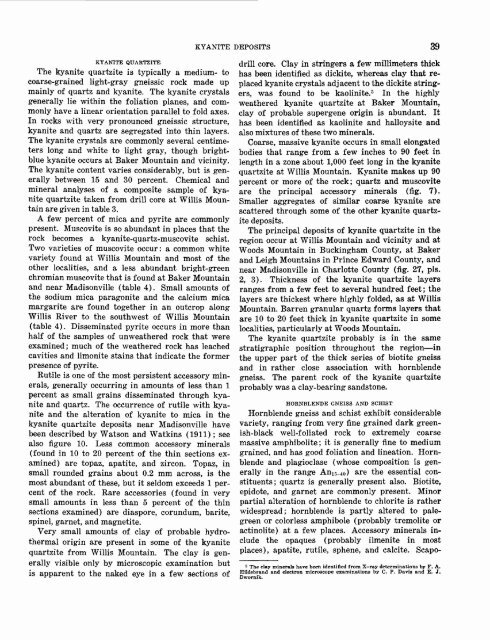Kyanite, Sillimanite, and Andalusite Deposits of the Southeastern ...
Kyanite, Sillimanite, and Andalusite Deposits of the Southeastern ...
Kyanite, Sillimanite, and Andalusite Deposits of the Southeastern ...
You also want an ePaper? Increase the reach of your titles
YUMPU automatically turns print PDFs into web optimized ePapers that Google loves.
KYANITE DEPOSITS 39<br />
KYANITE QUARTZITE<br />
The kyanite quartzite is typically a medium- to<br />
coarse-grained light-gray gneissic rock made up<br />
mainly <strong>of</strong> quartz <strong>and</strong> kyanite. The kyanite crystals<br />
generally lie within <strong>the</strong> foliation planes, <strong>and</strong> commonly<br />
have a linear orientation parallel to fold axes.<br />
In rocks with very pronounced gneissic structure,<br />
kyanite <strong>and</strong> quartz are segregated into thin layers.<br />
The kyanite crystals are commonly several centimeters<br />
long <strong>and</strong> white to light gray, though brightblue<br />
kyanite occurs at Baker Mountain <strong>and</strong> vicinity.<br />
The kyanite content varies considerably, but is generally<br />
between 15 <strong>and</strong> 30 percent. Chemical <strong>and</strong><br />
mineral analyses <strong>of</strong> a composite sample <strong>of</strong> kyanite<br />
quartzite taken from drill core at Willis Mountain<br />
are given in table 3.<br />
A few percent <strong>of</strong> mica <strong>and</strong> pyrite are commonly<br />
present. Muscovite is so abundant in places that <strong>the</strong><br />
rock becomes a kyanite-quartz-muscovite schist.<br />
Two varieties <strong>of</strong> muscovite occur: a common white<br />
variety found at Willis Mountain <strong>and</strong> most <strong>of</strong> <strong>the</strong><br />
o<strong>the</strong>r localities, <strong>and</strong> a less abundant bright-green<br />
chromian muscovite that is found at Baker Mountain<br />
<strong>and</strong> near Madisonville (table 4). Small amounts <strong>of</strong><br />
<strong>the</strong> sodium mica paragonite <strong>and</strong> <strong>the</strong> calcium mica<br />
margarite are found toge<strong>the</strong>r in an outcrop along<br />
Willis River to <strong>the</strong> southwest <strong>of</strong> Willis Mountain<br />
(table 4). Disseminated pyrite occurs in more than<br />
half <strong>of</strong> <strong>the</strong> samples <strong>of</strong> unwea<strong>the</strong>red rock that were<br />
examined; much <strong>of</strong> <strong>the</strong> wea<strong>the</strong>red rock has leached<br />
cavities <strong>and</strong> limonite stains that indicate <strong>the</strong> former<br />
presence <strong>of</strong> pyrite.<br />
Rutile is one <strong>of</strong> <strong>the</strong> most persistent accessory minerals,<br />
generally occurring in amounts <strong>of</strong> less than 1<br />
percent as small grains disseminated through kyanite<br />
<strong>and</strong> quartz. The occurrence <strong>of</strong> rutile with kyanite<br />
<strong>and</strong> <strong>the</strong> alteration <strong>of</strong> kyanite to mica in <strong>the</strong><br />
kyanite quartzite deposits near Madisonville have<br />
been described by Watson <strong>and</strong> Watkins (1911); see<br />
also figure 10. Less common accessory minerals<br />
(found in 10 to 20 percent <strong>of</strong> <strong>the</strong> thin sections examined)<br />
are topaz, apatite, <strong>and</strong> zircon. Topaz, in<br />
small rounded grains about 0.2 mm across, is <strong>the</strong><br />
most abundant <strong>of</strong> <strong>the</strong>se, but it seldom exceeds 1 percent<br />
<strong>of</strong> <strong>the</strong> rock. Rare accessories (found in very<br />
small amounts in less than 5 percent <strong>of</strong> <strong>the</strong> thin<br />
sections examined) are diaspore, corundum, barite,<br />
spinel, garnet, <strong>and</strong> magnetite.<br />
Very small amounts <strong>of</strong> clay <strong>of</strong> probable hydro<strong>the</strong>rmal<br />
origin are present in some <strong>of</strong> <strong>the</strong> kyanite<br />
quartzite from Willis Mountain. The clay is generally<br />
visible only by microscopic examination but<br />
is apparent to <strong>the</strong> naked eye in a few sections <strong>of</strong><br />
drill core. Clay in stringers a few millimeters thick<br />
has been identified as dickite, whereas clay that replaced<br />
kyanite crystals adjacent to <strong>the</strong> dickite string<br />
ers, was found to be kaolinite. 5 In <strong>the</strong> highly<br />
wea<strong>the</strong>red kyanite quartzite at Baker Mountain,<br />
clay <strong>of</strong> probable supergene origin is abundant. It<br />
has been identified as kaolinite <strong>and</strong> halloysite <strong>and</strong><br />
also mixtures <strong>of</strong> <strong>the</strong>se two minerals.<br />
Coarse, massive kyanite occurs in small elongated<br />
bodies that range from a few inches to 90 feet in<br />
length in a zone about 1,000 feet long in <strong>the</strong> kyanite<br />
quartzite at Willis Mountain. <strong>Kyanite</strong> makes up 90<br />
percent or more <strong>of</strong> <strong>the</strong> rock; quartz <strong>and</strong> muscovite<br />
are <strong>the</strong> principal accessory minerals (fig. 7).<br />
Smaller aggregates <strong>of</strong> similar coarse kyanite are<br />
scattered through some <strong>of</strong> <strong>the</strong> o<strong>the</strong>r kyanite quartzite<br />
deposits.<br />
The principal deposits <strong>of</strong> kyanite quartzite in <strong>the</strong><br />
region occur at Willis Mountain <strong>and</strong> vicinity <strong>and</strong> at<br />
Woods Mountain in Buckingham County, at Baker<br />
<strong>and</strong> Leigh Mountains in Prince Edward County, <strong>and</strong><br />
near Madisonville in Charlotte County (fig. 27, pis.<br />
2, 3). Thickness <strong>of</strong> <strong>the</strong> kyanite quartzite layers<br />
ranges from a few feet to several hundred feet; <strong>the</strong><br />
layers are thickest where highly folded, as at Willis<br />
Mountain. Barren granular quartz forms layers that<br />
are 10 to 20 feet thick in kyanite quartzite in some<br />
localities, particularly at Woods Mountain.<br />
The kyanite quartzite probably is in <strong>the</strong> same<br />
stratigraphic position throughout <strong>the</strong> region in<br />
<strong>the</strong> upper part <strong>of</strong> <strong>the</strong> thick series <strong>of</strong> biotite gneiss<br />
<strong>and</strong> in ra<strong>the</strong>r close association with hornblende<br />
gneiss. The parent rock <strong>of</strong> <strong>the</strong> kyanite quartzite<br />
probably was a clay-bearing s<strong>and</strong>stone.<br />
HORNBLENDE GNEISS AND SCHIST<br />
Hornblende gneiss <strong>and</strong> schist exhibit considerable<br />
variety, ranging from very fine grained dark greenish-black<br />
well-foliated rock to extremely coarse<br />
massive amphibolite; it is generally fine to medium<br />
grained, <strong>and</strong> has good foliation <strong>and</strong> lineation. Hornblende<br />
<strong>and</strong> plagioclase (whose composition is generally<br />
in <strong>the</strong> range An15_40 ) are <strong>the</strong> essential constituents;<br />
quartz is generally present also. Biotite,<br />
epidote, <strong>and</strong> garnet are commonly present. Minor<br />
partial alteration <strong>of</strong> hornblende to chlorite is ra<strong>the</strong>r<br />
widespread; hornblende is partly altered to palegreen<br />
or colorless amphibole (probably tremolite or<br />
actinolite) at a few places. Accessory minerals include<br />
<strong>the</strong> opaques (probably ilmenite in most<br />
places), apatite, rutile, sphene, <strong>and</strong> calcite. Scapo-<br />
3 The clay minerals have been identified from X-ray determinations by F. A.<br />
Hildebr<strong>and</strong> <strong>and</strong> electron microscope examinations by C. P. Da vis <strong>and</strong> E. J.<br />
Dwornik.
















